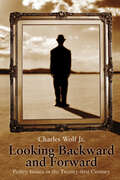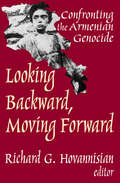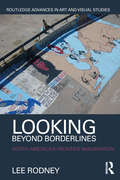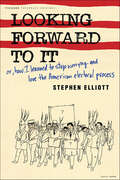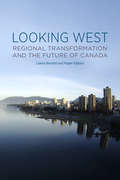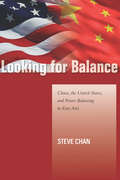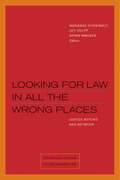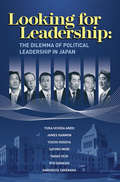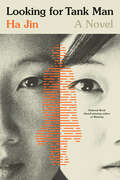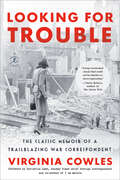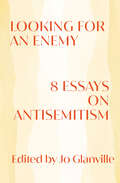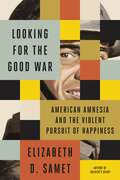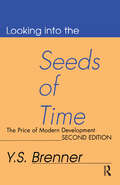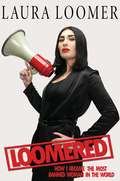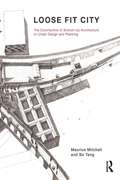- Table View
- List View
Looking Back on President Barack Obama’s Legacy: Hope And Change
by Wilbur C. RichWhen President Barack Hussein Obama left office January 20, 2017, he left a fascinating legacy. The Obama Presidency will remain an intriguing part of our nation’s political history, and we can now say that there were unexpected achievements and failures. His tenure was both historical and complex, and will inevitably be compared with his predecessors and successors. The chapters in this volume are a serious assessment of President Obama’s tenure written by a diverse team that includes political scientists, sociologists, historians, and economists. They provide critical insights into the man and his policies and, more importantly, are written in a manner that makes them available to laypersons, journalists, students, and scholars.
Looking Back on the Vietnam War: Twenty-first-Century Perspectives
by Robert Mason Heonik Kwon Leonie Jones Viet Thanh Nguyen Cathy J. Schlund-Vials Vinh Nguyen Jeehyun Lim Professor Yen Le Espiritu Brenda M. Boyle Diane Niblack Fox Lan Duong Quan Tue TranMore than forty years have passed since the official end of the Vietnam War, yet the war's legacies endure. Its history and iconography still provide fodder for film and fiction, communities of war refugees have spawned a wide Vietnamese diaspora, and the United States military remains embroiled in unwinnable wars with eerie echoes of Vietnam. Looking Back on the Vietnam War brings together scholars from a broad variety of disciplines, who offer fresh insights on the war's psychological, economic, artistic, political, and environmental impacts. Each essay examines a different facet of the war, from its representation in Marvel comic books to the experiences of Vietnamese soldiers exposed to Agent Orange. By putting these pieces together, the contributors assemble an expansive yet nuanced composite portrait of the war and its global legacies. Though they come from diverse scholarly backgrounds, ranging from anthropology to film studies, the contributors are united in their commitment to original research. Whether exploring rare archives or engaging in extensive interviews, they voice perspectives that have been excluded from standard historical accounts. Looking Back on the Vietnam War thus embarks on an interdisciplinary and international investigation to discover what we remember about the war, how we remember it, and why.
Looking Backward and Forward: Policy Issues in the Twenty-first Century
by Charles Wolf Jr.This collection of twenty-five essays written over the past five years by international economic policy expert Charles Wolf Jr. covers a range of worldwide economic, political, security, and diplomatic issues. Wolf looks at the challenges facing the United States at home and around the globe including critical issues regarding China, Japan, Korea, Russia, Iraq, and other key locales. Throughout the book, the author offers his often-controversial viewpoints, such as his assertion that "unilateralism" in U.S. national security policy may sometimes be preferable to multilateralism or that the erroneous expectation that Iraq possessed nuclear weapons does not imply that the intelligence leading to this expectation was flawed. Wolf reexamines each essay in the light of later developments with a "postaudit" comment to address whether the original argument is still valid and relevant compared with when it was first written.
Looking Backward, Moving Forward: Confronting the Armenian Genocide
by Richard G. HovannisianThe decades separating our new century from the Armenian Genocide, the prototype of modern-day nation-killings, have fundamentally changed the political composition of the region. Virtually no Armenians remain on their historic territories in what is today eastern Turkey. The Armenian people have been scattered about the world. And a small independent republic has come to replace the Armenian Soviet Socialist Republic, which was all that was left of the homeland as the result of Turkish invasion and Bolshevik collusion in 1920. One element has remained constant. Notwithstanding the eloquent, compelling evidence housed in the United States National Archives and repositories around the world, successive Turkish governments have denied that the predecessor Young Turk regime committed genocide, and, like the Nazis who followed their example, sought aggressively to deflect blame by accusing the victims themselves.This volume argues that the time has come for Turkey to reassess the propriety of its approach, and to begin the process that will allow it move into a post-genocide era. The work includes "Genocide: An Agenda for Action," Gijs M. de Vries; "Determinants of the Armenian Genocide," Donald Bloxham; "Looking Backward and Forward," Joyce Apsel; "The United States Response to the Armenian Genocide," Simon Payaslian; "The League of Nations and the Reclamation of Armenian Genocide Survivors," Vahram L. Shemmassian; "Raphael Lemkin and the Armenian Genocide," Steven L. Jacobs; "Reconstructing Turkish Historiography of the Armenian Massacres and Deaths of 1915," Fatma Muge Go;cek; "Bitter-Sweet Memories; "The Armenian Genocide and International Law," Joe Verhoeven; "New Directions in Literary Response to the Armenian Genocide," Rubina Peroomian; "Denial and Free Speech," Henry C. Theriault; "Healing and Reconciliation," Ervin Staub; "State and Nation," Raffi K. Hovannisian.
Looking Beyond Borderlines: North America's Frontier Imagination (Routledge Advances in Art and Visual Studies)
by Lee RodneyAmerican territorial borders have undergone significant and unparalleled changes in the last decade. They serve as a powerful and emotionally charged locus for American national identity that correlates with the historical idea of the frontier. But the concept of the frontier, so central to American identity throughout modern history, has all but disappeared in contemporary representation while the border has served to uncomfortably fill the void left in the spatial imagination of American culture. This book focuses on the shifting relationship between borders and frontiers in North America, specifically the ways in which they have been imaged and imagined since their formation in the 19th century and how tropes of visuality are central to their production and meaning. Rodney links ongoing discussions in political geography and visual culture in new ways to demonstrate how contemporary American borders exhibit security as a display strategy that is resisted and undermined through a variety of cultural practices.
Looking Down the Corridors: Allied Aerial Espionage Over East Germany and Berlin, 1945-1990
by Kevin Wright Mike Jackson Peter JefferiesThis is the only book, written by experts with first-hand knowledge, to examine in detail the clandestine reconnaissance operations over East Germany during the Cold War era. Between 1945 and 1990 the wartime Western Allies mounted some of the most audacious and successful photographic intelligence collection operations using their freedom of access to the internationally agreed airspace of the Berlin Air Corridors and Control Zone that passed over a large area of East Germany. The operations were authorised at the highest political levels and conducted in great secrecy used modified transport and training aircraft disguised as normal transport and training flights exercising the Allies' access rights to Berlin and its environs. For nearly 50 years these flights gathered a prodigious amount of imagery that was analysed by intelligence analysts to provide the western intelligence community with unique knowledge of the organisation and equipment of the Warsaw Pact forces. Using recently declassified materials and extensive personal interviews with those involved at all levels this book provides, for the first time, a detailed account and analysis of these operations and their unique contribution to the Cold War intelligence picture.
Looking Forward to It: Or, How I Learned to Stop Worrying and Love the American Electoral Process
by Stephen ElliottStephen Elliott does not know what to think of American voters, this year's desperate and heated run for presidency, or the legitimacy of the political system. He doesn't know whether to love John Kerry or try to love Howard Dean or try, simply, to get excited about Politics. But what he does know is that most Americans are as confused, taxed and broken-hearted as he is. Looking Forward To It is the chronicle of one ordinary fellow's skeptical -- and hilarious -- journey through the election process. It is on the campaign trail that he will meet washed-out campaign managers, idealistic publicists, corrupt journalists, world-weary auditorium janitors, recovering drug addicts, and, of course, politicians. His report documents a journey into the center of "the thing", our country, where Americans high and low come together to participate in the most profound gesture of democracy: the election.
Looking West: Regional Transformation And The Future Of Canada
by Loleen Berdahl Roger GibbinsAlthough a history of protest politics has done so much to define western Canada and to place it outside the Canadian mainstream, the aspirations and frustrations that animated western discontent over the years have been replaced by a new reality: the West is in, and many of the levers of national economic and political power rest in western Canadian hands. The protest tradition has yielded a dynamic region that leads rather than reacts to national economic, social, and political change. The westward shift of the Canadian economy and demography is likely to be an enduring structural change that reflects and is reinforced by the transformation of the continental and global economies. At the same time, western Canada faces major challenges, including finding a place for a sustainable resource economy in a rapidly changing global environment, establishing a full and modern partnership with Aboriginal peoples, and creating urban environments that will attract and retain human capital. None of these challenges are unique to the West but they all play out with great force, and great immediacy, in western Canada.
Looking at Lincoln
by Maira KalmanAbraham Lincoln is one of the first giants of history children are introduced to, and now Maira Kalman brings him to life with her trademark style and enthusiasm. Lincoln's legacy is everywhere - there he is on your penny and five-dollar bill. And we are still the United States because Lincoln helped hold them together. But who was he, really? The little girl in this book wants to find out. Among the many other things, she discovers our sixteenth president was a man who believed in freedom for all, had a dog named Fido, loved Mozart, apples, and his wife's vanilla cake, and kept his notes in his hat. From his boyhood in a log cabin to his famous presidency and untimely death, Kalman shares Lincoln's remarkable life with young readers in a fresh and exciting way.
Looking behind the Label
by Nik Summers Hiram Samel Sebastian Koos Tim Bartley Gustavo SetriniWhat does it mean when consumers "shop with a conscience" and choose products labeled as fair or sustainable? Does this translate into meaningful changes in global production processes? To what extent are voluntary standards implemented and enforced, and can they really govern global industries? Looking behind the Label presents an informative introduction to global production and ethical consumption, tracing the links between consumers' choices and the practices of multinational producers and retailers. Case studies of several types of products--wood and paper, food, apparel and footwear, and electronics--are used to reveal what lies behind voluntary rules and to critique predominant assumptions about ethical consumption as a form of political expression.
Looking for Balance
by Steve ChanDebate surrounding "China's rise," and the prospects of its possible challenge to America's preeminence in international relations in East Asia, has focused on two questions, rooted in power-balancing theory: whether the United States should "contain" or "engage" China; and whether the rise of Chinese power has inclined other East Asian states to "balance" against Beijing by alignment with the United States. By drawing on alternative theoretic approaches-most especially "balance-of-threat" theory, political economic theory, and theories surrounding regime survival in multilateral rather than bilateral contexts, Steve Chan is able to create an explanation of what is in motion in the region that differs widely from the traditional "strategic vision" of national interest. He concludes that China's primary IR aim is not to match U. S. military might or the foreign policy influence that flows from that power, and that its neighbors are not balancing against its rising power. This is because, in today's guns-versus-butter fiscal reality, balancing policies would entail forfeiting possible gains that can accrue from cooperation, economic growth, and the application of GDP to nonmilitary ends. Instead, most East Asian countries have collectively pivoted to a strategy of elite legitimacy and regime survival based on economic performance.
Looking for Law in All the Wrong Places: Justice Beyond and Between (Berkeley Forum in the Humanities)
by Wendy Brown Saba Mahmood Daniel Boyarin Christopher Tomlins Samera Esmeir Ramona Naddaff Kathryn Abrams Sara Ludin Sarah Song Rebecca M. McLennan Bath H. Piatote Daniel FisherFor many inside and outside the legal academy, the right place to look for law is in constitutions, statutes, and judicial opinions. This book looks for law in the “wrong places”—sites and spaces in which no formal law appears. These may be geographic regions beyond the reach of law, everyday practices ungoverned or ungovernable by law, or works of art that have escaped law’s constraints.Looking for Law in All the Wrong Places brings together essays by leading scholars of anthropology, cultural studies, history, law, literature, political science, race and ethnic studies, religion, and rhetoric, to look at law from the standpoint of the humanities. Beyond showing law to be determined by or determinative of distinct cultural phenomena, the contributors show how law is itself interwoven with language, text, image, and culture.Many essays in this volume look for law precisely in the kinds of “wrong places” where there appears to be no law. They find in these places not only reflections and remains of law, but also rules and practices that seem indistinguishable from law and raise challenging questions about the locations of law and about law’s meaning and function. Other essays do the opposite: rather than looking for law in places where law does not obviously appear, they look in statute books and courtrooms from perspectives that are usually presumed to have nothing to say about law.Looking at law sideways, or upside down, or inside out defamiliarizes law. These essays show what legal understanding can gain when law is denied its ostensibly proper domain.Contributors: Kathryn Abrams, Daniel Boyarin, Wendy Brown, Marianne Constable, Samera Esmeir, Daniel Fisher, Sara Ludin, Saba Mahmood, Rebecca McLennan, Ramona Naddaff, Beth Piatote, Sarah Song, Christopher Tomlins, Leti Volpp, Bryan Wagner
Looking for Leadership: The Dilemma of Political Leadership in Japan
by Ryo Sahashi James GannonDemocratic leaders around the world are finding it increasingly difficult to exercise strong leadership and maintain public support. However, there is nowhere that this has proven to be as challenging of a task as Japan, which has seen its top leaders change more often over the past 25 years than any other major country in the world. The current prime minister has strived to put an end to this pattern, but can he buck this historical trend? More fundamentally, why do Japan's prime ministers find it so difficult to project strong leadership, or even stay in office? And what are the ramifications for Japan's partners and for the world? This volume, authored by contributors who straddle the scholarly and policymaking worlds in Japan, explores the obstacles facing Japan as it looks for greater leadership and explains why this matters for the rest of the world.
Looking for Rights in All the Wrong Places: Why State Constitutions Contain America's Positive Rights (Princeton Studies in American Politics: Historical, International, and Comparative Perspectives #132)
by Emily ZackinUnlike many national constitutions, which contain explicit positive rights to such things as education, a living wage, and a healthful environment, the U.S. Bill of Rights appears to contain only a long list of prohibitions on government. American constitutional rights, we are often told, protect people only from an overbearing government, but give no explicit guarantees of governmental help. Looking for Rights in All the Wrong Places argues that we have fundamentally misunderstood the American rights tradition. The United States actually has a long history of enshrining positive rights in its constitutional law, but these rights have been overlooked simply because they are not in the federal Constitution. Emily Zackin shows how they instead have been included in America's state constitutions, in large part because state governments, not the federal government, have long been primarily responsible for crafting American social policy. Although state constitutions, seemingly mired in trivial detail, can look like pale imitations of their federal counterpart, they have been sites of serious debate, reflect national concerns, and enshrine choices about fundamental values. Zackin looks in depth at the history of education, labor, and environmental reform, explaining why America's activists targeted state constitutions in their struggles for government protection from the hazards of life under capitalism. Shedding much-needed light on the variety of reasons that activists pursued the creation of new state-level rights, Looking for Rights in All the Wrong Places challenges us to rethink our most basic assumptions about the American constitutional tradition.
Looking for Tank Man: A Novel
by Ha JinA Harvard student from China discovers the fraught, hidden history of the Tiananmen Square massacre in this powerful novel of protest and suppression from the National Book Award–winning author.When the Chinese premier visits Harvard, international student Pei Lulu encounters a lone protester, who will drastically change her understanding of the People's Republic and her own place in the world. For the first time, Lulu learns of the 1989 protest movement and the government&’s violent response. Determined to find out more, she seeks answers from her family, who share surprising stories of their involvement, and from a formative university course based on powerful firsthand accounts.At once a compelling coming-of-age tale and a poignant tribute to the courage of activists, Looking for Tank Man keeps this tragedy alive in the public memory and warns against the dangers of authoritarian regimes.
Looking for Trouble: The Classic Memoir of a Trailblazing War Correspondent
by Virginia CowlesThe rediscovered memoir of an American gossip columnist turned &“amazingly brilliant reporter&” (The New York Times Book Review) as she reports from the frontlines of the Spanish Civil War and World War II&“A long-overlooked classic that could not be timelier or more engrossing.&”—Paula McLain, author of The Paris WifeForeword by Christina Lamb, Sunday Times chief foreign correspondent and co-author of I Am Malala Virginia Cowles was just twenty-seven years old when she decided to transform herself from a society columnist into a foreign press correspondent. Looking for Trouble is the story of this evolution, as Cowles reports from both sides of the Spanish Civil War, London on the first day of the Blitz, Nazi-run Munich, and Finland&’s bitter, bloody resistance to the Russian invasion. Along the way, Cowles also meets Adolf Hitler (&“an inconspicuous little man&”), Benito Mussolini, Winston Churchill, Martha Gellhorn, and Ernest Hemingway. Her reportage blends sharp political analysis with a gossip columnist&’s chatty approachability and a novelist&’s empathy. Cowles understood in 1937—long before even the average politician—that Fascism in Europe was a threat to democracy everywhere. Her insights on extremism are as piercing and relevant today as they were eighty years ago.
Looking for Votes in All the Wrong Places: Tales and Rules from the Campaign Trail
by Rick RidderThe veteran presidential campaign manager recounts his many adventures, travesties, triumphs, and lessons from more than forty years on the trail. Over his long and legendary career, campaign strategist Rick Ridder has been at the center of everything from presidential death matches to the legalization of marijuana. In this lively memoir, he recounts his life on the trail from the McGovern campaign to more recent candidates and causes. Along the way, he reveals his &“twenty-two rules of campaign management&”―each one illustrated by entertaining, instructive, and mostly true stories from his own experiences. Rick offers an unsparing, often hilarious self-portrait of the political guru as a young man, criss-crossing the country from one drafty campaign headquarters to the next, making mistakes and pulling rabbits out of hats, wrangling temperamental celebrities, winning some elections and losing others. Through his stories, you&’ll meet the state legislature candidate who said he&’d win thanks to his reputation as a judge in cat competitions; the US Senate candidate who told the Southern press, &“I hate southern accents&”; a young Senator Al Gore who campaigned for President in 1988 by eating his way through New York City alongside Mayor Koch; Leonard Nimoy, good-naturedly trekking through rural Wisconsin in Rick&’s own Jeep because Rick was too young to rent a more appropriate vehicle; and many other colorful characters.
Looking for Work in Post-Socialist China: Governance, Active Job Seekers and the New Chinese Labour Market (Routledge Contemporary China Series)
by Feng XuUnemployment is one of the most politically explosive issues in China and has gained further prominence as a result of the present global financial crisis. The novelty, urgency, and complexity of Chinese unemployment have compelled the government to experiment with policy initiatives that originate in the West. This book argues that although China is not a liberal democracy, it has turned to neo-liberal forms of governance to deal with unemployment, which now function alongside pre-existing Chinese modes of governance. This book examines the initiatives which represent China’s attempt to institutionalize and humanize its approach to governance: these initiatives include training programmes; counselling; a web-based national labour-market information network; insurance; and using community (shequ) organizations as the base for new mechanisms of governance and informal job generation. Based on extensive original research including semi-structured interviews, the book discusses the ways in which the government combines the new techniques with old campaign-style policy techniques. The author argues that these multiple modes of governance make the state's power visible in the new Chinese labour market, and at the same time run the risk of policy incoherence or even failure.
Looking for an Enemy: 8 Essays on Antisemitism
by Jo GlanvilleGreat Jewish thinkers offer salient historical commentary on the roots of antisemitism and its contemporary resurgence. From medieval accusations that Jews murder Christians for their blood to the far-right conspiracy theories animating present-day political discourse, it’s clear that the belief that Jews are plotting against society never dies—it just adapts to suit the times. In eight illuminating essays from brilliant Jewish writers and thinkers, Looking for an Enemy offers an urgent, profound take on the experience of antisemitism and its historical context. In order to present a nuanced, global understanding of antisemitism, editor Jo Glanville solicited essays from writers across a wide spectrum of ages, political ideologies, and nationalities. American rabbi Jill Jacobs and respected Israeli historian Tom Segev explore the thorny question of antisemitism in politics. British journalist Daniel Trilling investigates how antisemitism drives far-right extremism, while author Philip Spencer rethinks the forms that antisemitism takes on the left. Polish writer Mikolaj Grynberg reflects on a childhood shadowed by the trauma of the Holocaust; journalist Natasha Lehrer and novelist Olga Grjasnowa explore the culture of antisemitism, and the forces behind it, in France and Germany. In her own contribution, Glanville searches for the historical roots of this dangerous hatred. In moving memoir, rich history, and incisive political commentary, these essays navigate the complex differences in each country’s relationship to its Jewish citizens and reveal the contemporary face of antisemitism. Eye-opening and evocative, Looking for an Enemy explores how an irrational belief can still flourish in a supposedly rational age.
Looking for the Good War: American Amnesia and the Violent Pursuit of Happiness
by Elizabeth D. Samet"Essential reading. This eloquent, far-ranging analysis of the national psyche goes as far as any book I've ever read toward explaining the peculiar American yen for war and more war." —Ben Fountain, author of Billy Lynn's Long Halftime Walk and Beautiful Country Burn AgainIn Looking for the Good War, Elizabeth D. Samet reexamines the literature, art, and culture that emerged after World War II, bringing her expertise as a professor of English at West Point to bear on the complexity of the postwar period in national life. She exposes the confusion about American identity that was expressed during and immediately after the war, and the deep national ambivalence toward war, violence, and veterans—all of which were suppressed in subsequent decades by a dangerously sentimental attitude toward the United States’ “exceptional” history and destiny. Samet finds the war's ambivalent legacy in some of its most heavily mythologized figures: the war correspondent epitomized by Ernie Pyle, the character of the erstwhile G.I. turned either cop or criminal in the pulp fiction and feature films of the late 1940s, the disaffected Civil War veteran who looms so large on the screen in the Cold War Western, and the resurgent military hero of the post-Vietnam period. Taken together, these figures reveal key elements of postwar attitudes toward violence, liberty, and nation—attitudes that have shaped domestic and foreign policy and that respond in various ways to various assumptions about national identity and purpose established or affirmed by World War II.As the United States reassesses its roles in Afghanistan and the Middle East, the time has come to rethink our national mythology: the way that World War II shaped our sense of national destiny, our beliefs about the use of American military force throughout the world, and our inability to accept the realities of the twenty-first century’s decades of devastating conflict.
Looking for the Possible Dance
by A.L. KennedyMary Margaret Hamilton was educated in Scotland. She was born there too. These may not have been the best possible options, but they were the only ones on offer at the time. Although her father did his best, her knowledge of life is perhaps a little incomplete. Margaret knows the best way to look at the moon, how to wake on time and how to breathe fire. Now she must learn how to live. A. L. Kennedy's absorbing, moving and gently political first novel dissects the intricate difficulties of human relationships, from Margaret's passionate attachment to her father and her more problematic involvement with Colin, her lover, to the wider social relations between pupil and teacher, employer and employee, individual and state.
Looking into the Seeds of Time: The Price of Modern Development
by Y. S. BrennerThis stunning, refreshing work combines the history of economics and the practice of modern development. It is predicated on Brenner's view that there is no individual freedom without economic security, and that such security depends upon progress in both the natural and social sciences. Social institutions determine the pace and direction of technological advancement and scientific and technological achievements determine which forms of social reorganization are possible and which are illusory. As all living is action, and living implies choices, any theory of development must start with the person. Economic laws obtain only in relation to specific forms of social existence. Advanced societies are technically capable of providing for basic needs but are not yet convinced of their ability to do so. Modern life still reflects the fears of a society still trying to escape the anxieties, demons, and ghosts of a long dark era of unemployment and starvation. The problem of development is the contradiction between technological potentials and cultural inheritances. Looking into the Seeds of Time was originally written with the belief that the growing mastery of nature by humanity would curb egoistic impulses and replace competitive with cooperative goals. While the same spirit pervades this new edition, the work reveals how political as well as economic processes make the goals of prosperity harder to achieve. The work reveals a rare insight into the mechanisms of the marketplace, and how they can be examined in a comparative, historical context-across nations as different as the United States, Great Britain and Japan, and from the Reformation to the modern era of bourgeois consolidation. This is institutional economics at its very best.
Loomered: How I Became the Most Banned Woman in the World
by Laura LoomerLaura Loomer is the most banned woman in the world.An investigative journalist, activist, and truth-teller who has earned many powerful enemies in Silicon Valley and the media, Loomer has been banned from Facebook, Twitter, Instagram, Uber, Lyft, Uber Eats, PayPal, Venmo, GoFundMe, Periscope, Medium, and TeeSpring…so far. Loomer works tirelessly for Americans banned from essential online services for having the wrong political opinions. In addition to filing lawsuits against the companies that have wrongfully ostracized and defamed her, she is running for Congress in Florida&’s 21st District. This is her story.
Loose Fit City: The Contribution of Bottom-Up Architecture to Urban Design and Planning
by Maurice Mitchell Bo TangDrawn from a lifetime’s experience of shared city-making from the bottom up, within rapidly expanding urban metabolisms in Delhi, Mumbai, Agra, Kathmandu, West Africa and London, Loose Fit City is about the ways in which city residents can learn through making to engage with the dynamic process of creating their own city. It looks at the nature and processes involved in loosely fitting together elements made by different people at different scales and times, with different intentions, into a civic entity which is greater than the sum of its parts. It shows how bottom-up learning through making can create a more vibrant and democratic city than the more flattened, top-down, centrally planned, factory made version. Loose Fit City provides a new take on the subject of architecture, defined as the study and practice of fitting together physical and cultural topography. It provides a comprehensive view of how the fourth dimension of time fits loosely together with the three spatial dimensions at different scales within the human horizon, so as to layer meaning and depth within the places and metabolism of the city fabric.
Loose Space: Possibility and Diversity in Urban Life
by Karen A. Franck Quentin StevensIn cities around the world people use a variety of public spaces to relax, to protest, to buy and sell, to experiment and to celebrate. Loose Space explores the many ways that urban residents, with creativity and determination, appropriate public space to meet their own needs and desires. Familiar or unexpected, spontaneous or planned, momentary or long-lasting, the activities that make urban space loose continue to give cities life and vitality. The book examines physical spaces and how people use them. Contributors discuss a wide range of recreational, commercial and political activities; some are conventional, others are more experimental. Some of the activities occur alongside the intended uses of planned public spaces, such as sidewalks and plazas; other activities replace former uses, as in abandoned warehouses and industrial sites. The thirteen case studies, international in scope, demonstrate the continuing richness of urban public life that is created and sustained by urbanites themselves Presents a fresh way of looking at urban public space, focusing on its positive uses and aspects. Comprises 13 detailed, well-illustrated case studies based on sustained observation and research by social scientists, architects and urban designers. Looks at a range of activities, both everyday occurrences and more unusual uses, in a variety of public spaces -- planned, leftover and abandoned. Explores the spatial and the behavioral; considers the wider historical and social context. Addresses issues of urban research, architecture, urban design and planning. Takes a broad international perspective with cases from New York, London, Berlin, Amsterdam, Rome, Guadalajara, Athens, Tel Aviv, Melbourne, Bangkok, Kandy, Buffalo, and the North of England.


